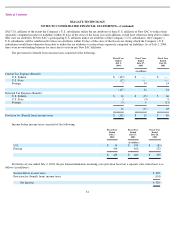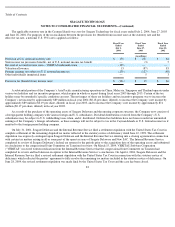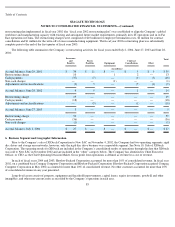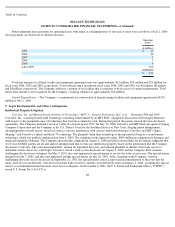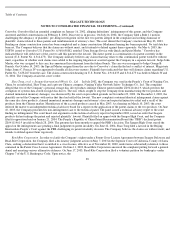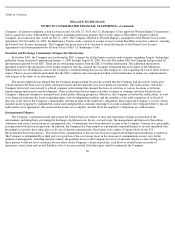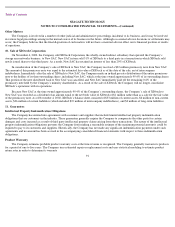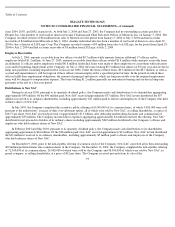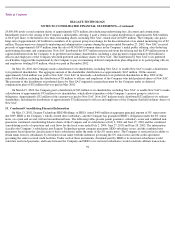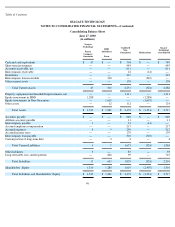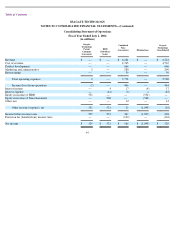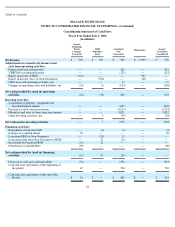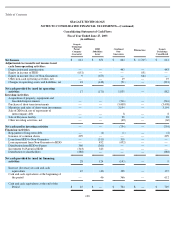Seagate 2003 Annual Report Download - page 92
Download and view the complete annual report
Please find page 92 of the 2003 Seagate annual report below. You can navigate through the pages in the report by either clicking on the pages listed below, or by using the keyword search tool below to find specific information within the annual report.
Table of Contents
SEAGATE TECHNOLOGY
NOTES TO CONSOLIDATED FINANCIAL STATEMENTS—(Continued)
Other Matters
The Company is involved in a number of other judicial and administrative proceedings incidental to its business, and it may be involved
in various legal proceedings arising in the normal course of its business in the future. Although occasional adverse decisions or settlements may
occur, the Company believes that the final disposition of such matters will not have a material adverse effect on its financial position or results
of operations.
10. Sale of XIOtech Corporation
On November 4, 2002, the Company sold XIOtech Corporation, the wholly-owned indirect subsidiary that operated the Company’s
storage area networks business, to New SAC. New SAC in turn sold 51% of XIOtech to a third party in a transaction in which XIOtech sold
newly issued shares to this third party. As a result, New SAC has retained an interest of less than 20% of XIOtech.
In consideration of the Company’s sale of XIOtech to New SAC, the Company received a $32 million promissory note from New SAC.
The amount of this promissory note was equal to the estimated fair value of XIOtech as of the date of the sale, net of intercompany
indebtedness. Immediately after the sale of XIOtech to New SAC, the Company made an in-kind pro rata distribution of the entire promissory
note to the holders of its then-
outstanding shares, including New SAC, which at the time owned approximately 99.4% of its outstanding shares.
That portion of the note distributed back to New SAC was cancelled, and New SAC immediately paid off the remaining 0.6% of the
promissory note held by the Company’s minority shareholders. As a result of the sale of XIOtech, the Company will no longer consolidate
XIOtech’s operations with its operations.
Because New SAC at the time owned approximately 99.4% of the Company’s outstanding shares, the Company’s sale of XIOtech to
New SAC was recorded as a dividend of an amount equal to the net book value of XIOtech of $1 million rather than as a sale for the fair value
of the promissory note. As of November 4, 2002, XIOtech’s balance sheet consisted of $33 million of current assets, $6 million of non-current
assets, $36 million of current liabilities (which included $19 million of intercompany indebtedness), and $2 million of long-term liabilities.
11. Guarantees
Intellectual Property Indemnification Obligations
The Company has entered into agreements with customers and suppliers that include limited intellectual property indemnification
obligations that are customary in the industry. These guarantees generally require the Company to compensate the other party for certain
damages and costs incurred as a result of third party intellectual property claims arising from these transactions. The nature of the intellectual
property indemnification obligations prevents the Company from making a reasonable estimate of the maximum potential amount it could be
required to pay to its customers and suppliers. Historically, the Company has not made any significant indemnification payments under such
agreements and no amount has been accrued in the accompanying consolidated financial statements with respect to these indemnification
obligations.
Product Warranty
The Company estimates probable product warranty costs at the time revenue is recognized. The Company generally warrants its products
for a period of one to five years. The Company uses estimated repair or replacement costs and uses statistical modeling to estimate product
return rates in order to determine its warranty
91


